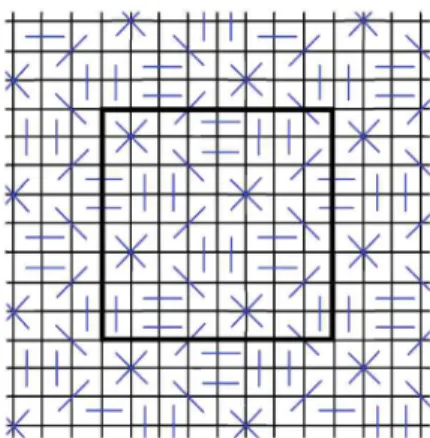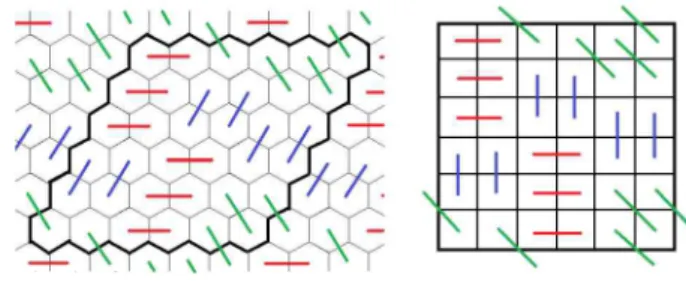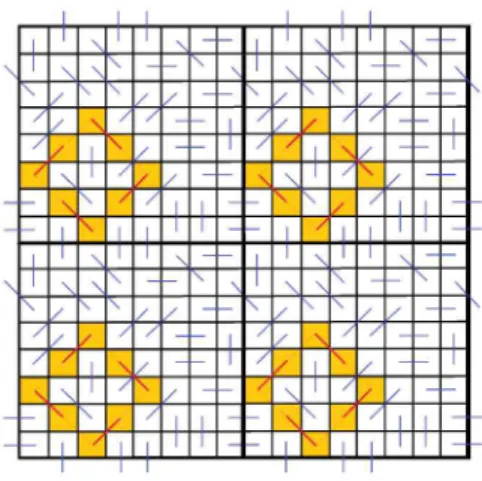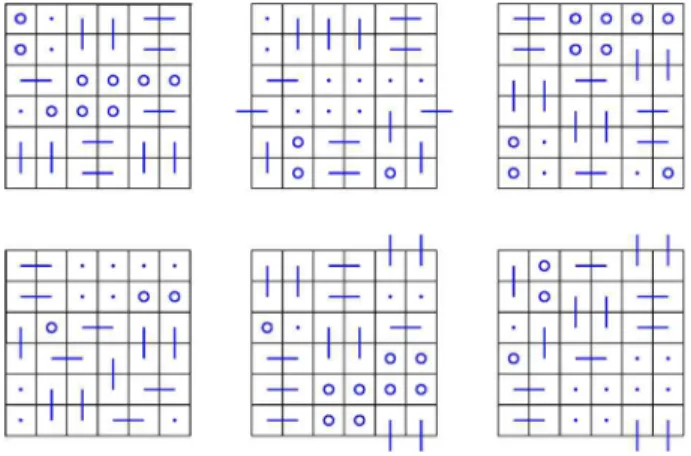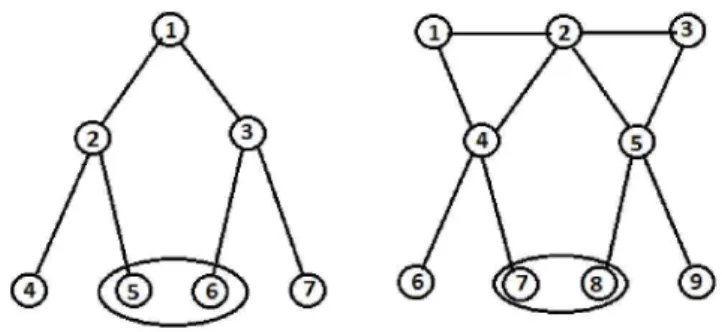Tic-Tac-Toe, Amoeba and other animals
Outline of Ph. D, thesis
La j o s Gy ő r f f y
Supervisor: Dr, András Pluhár associate professor
Doctoral School of Mathematics and Computer Science Bolyai Institute
University of Szeged, Faculty of Science and Informatics
Szeged, 2019
1 Introduction
In the thesis we investigate pairing strategies and their generalizations applied to h y p erg rap h gam es. We can define several games on a given hypergraph H = (V ,E ). The first and second players take ele
ments of V in turns. In the norm al version the player who is first to take all elements of some edge (winning set) A e E wins the game. A normal game can be either a first player win or a draw but the second player cannot win if both players play in a perfect way. The concept of strategy stealing was introduced by John Nash for a special game, hex, and rigorously proved in the general case by Alfred Hales and Robert Jew ett, see [8].
Since in the normal game the second player cannot win, we in
troduce the M a k e r-B re a k e r (M-B) games. In these, Maker wins by achieving the original goal, while Breaker wins by preventing Maker to doing so. A Maker-Breaker game can be either a Maker win or a Breaker win. Beside the M -B version, one can play accelerated or bi
ased versions of a hypergraph game, where the players can have more than one elements in one step. Jozsef Beck introduced the P ick er- C h o o ser (P-C) and C h o o se r-P ick e r (C-P) versions, where Picker selects a pair of elements and Chooser keeps one of these and gives the other one back to Picker. In the C-P version Chooser plays as Maker and Picker as Breaker, while the roles are swapped in the P-C game.
1.1 D efinition The vertices o f the k - in - a - r o w h y p e r g r a p h H k a,re the squares o f the infinite square grid, while the edges are the k-elem en t sets o f consecutive squares in a row horizontally, vertically o r diago
nally.
A normal or M -B game on H k is the k-in-a-row game. We know that the k-in-a-row is a first player win if k < 4, while the second player wins if k > 8. Allis solved the 5-in-a-row on the 19 x 19 board:
the first player wins, however, the case of infinite board is still only a conjecture (in the normal version). For k = 6, 7, the questions are also open, but draw and Breaker wins are conjectured.
We call a function s tra te g y , if it gives the next move of the player from the previous moves. The main topic of the thesis is the pair
ing strategy, but we mention some other possible strategies: cutting to sub-boards, the potential based Erdos-Selfridge method and also case-studies which last could give the winning strategies instantly, but studying all cases is already hopeless for small games.
2 Pairings
In a Breaker winning pairing strategy Breaker pairs the elements before the game and when Maker chooses an element Breaker chooses its pair in the next move. Picker (as Breaker) also can use a Breaker winning pairing strategy in a C-P game - giving the pairs to Chooser Picker can have one element of all pairs and win the game.
2.1 D e fin itio n Given a hypergraph H = (V, E ), where V = V (H ) and E = E (H ) C P (H ) = { S : S C V } are the set o f vertices and edges. A bijection p : X ^ Y , where X ,Y c V (H) and X n Y = 0 is a p a ir in g on the hypergraph H .
2 .2 D e fin itio n A p air (x ,p (x )) b lo c k s an edge A e E (H ), if A con
tains both elem ents o f the pair. I f the pairs o f p block all edges, we say
that p is a g o o d p a ir in g o f H .
We know for k-in-a-row games that Breaker wins by pairings in cases of k > 9, but not for smaller k values.
2 .3 T h e o re m (H a le s -Je w e tt) [6] B reaker wins the 9-in-a-row M -B gam e by a pairing strategy, i.e., there exists a good pairing fo r the 9-in-a-row.
e\1t e\
s /
\/
' \
/\
\
/
\/ /
/
\ N /\
s / /
\
/ /
\ / / i /\ \ \/
?
\
\1 / \
\s /
\/
\ \
/\
\ \/ / k
\/ /\ \ / /\
-
/
_LV / _L
Figure 1: Hales-Jewett pairing for 9-in-a-row
For a hypergraph H let d2(H) (briefly d2) be the greatest number of edges that can be blocked by two vertices of H, he., d2 is the maximal co-degree. We can call that value the b lo ck in g pow er of the pair, which can be at most k — 1 in case of k-in-a-row.
2 .4 P ro p o sitio n [2] I f there is a good pairing p fo r the hypergraph H = (V ,E ), then d2\X|/2 > |Q\ must hold fo r all X c V , where G = {A : A G E , A c X}.
2 .5 D efinition The hypergraph o f the 3-direction version o f k-in -a- row is hk on the squaregrid, where the edges are the k-elernent sets o f consecutive squares in a row along the vectors (1,0), (0,1) and (1,1).
If k < 4, then Maker wins. If k > 7, then Breaker wins by pairings.
The cases 5 and 6 are open problems here. According to Proposition 2.4 the sharp case here is k = 7 for which we can see a good pairings in Figure 2. The number of good pairings were also an open question.
Figure 2: A good pairing for the 7-in-a-row
If we consider only the vertical and horizontal directions then Maker wins if k < 4, and Brew er wins by pairings if k > 5. In one direction the threshold is between 2 and 3.
2 .6 D efinition We denote the hypergraph o f the 2-direction (vertical and horizontal) version o f k-in-a-row by Pk and the one direction (hor
izontal) version by E k .
3 Generalized pairings
We talk about two-colorings of a hypergraph, if we color the vertices by two colors. A two-coloring blocks an edge, if the edge contains
both colors. A coloring is a good coloring, if it blocks all edges of the hypergraph.
Since two-colorings can be considered as pairing of two subsets and similarly pairings can be considered as step-by-step colorongs, we de
fined a bridge between the two notions. This section is based to the results of the paper [3].
3.1 D efinition Let us call a subset o f the hypergraph H = (V, E) t- c a k e if it consists o f exactly t vertices o f H , with a previously given bipartition p, q o f its elements, where t G N ,t > 2 and l < p ,q G N,p, q < t , p + q = t. A t-cake is b a la n c e d if the two parts contain equal number o f elements, i. e. p = q.
3 .2 D efinition A t - p la c e m e n t is a non-overlapping placem en t o f cakes on the hypergraph, where the size o f every cake is a t m o s t t.
I f a t-placem en t fo r an even t contains only balanced t-cakes, we are talking about p -p a ir in g , where p = t/2.
3 .3 D efinition A t-cake b lo c k s a n A G E , if both parts o f the cake have a non-em pty intersection with A A t-placem en t T is a g o o d t- p la c e m e n t o f H , if all edges o f H are blocked by a cake o f T . An A G E o f H is an u n b lo c k e d ed g e, if there is no cake in T blocks A.
We see a kind of monotonicity: if there is a good t-placement for a hypergraph H, then there is a good (t + l)-placement for H.
Let us count the number of hypergraph edges can be blocked by a given cake, that is the blocking pow er o f th e cake. For a given t G N let dt be the greatest blocking number among all t-cakes. A t-cake with blocking number dt is called a b est t-cake.
3 .4 P ro p o sitio n I f there is a good t-placem en t o f H = (V, E ) such that d2/2 < d3/3 < • • • < dt/ t , then d |X| > |G| fo r every X C V, where G = {A : A G E , A C X }.
From now on we study the blocking power of the cakes for the k-in-a-row. Table 3 shows the maximal blocking power for t < 8.
t 2 3 4 5 6 7 8
dt k - 1 2k - 2 4k - 4 5k - 4 7k - 6 9k - 8 11k - 9 dtt 2k 1 k 21 2 k 3 k 2 3 k - 1 k - 5 6 k - 1 9 k 8
7k 7 11 k 8 k 89
k > 9 7 5 4.8 4.29 4 3.73
3.1 Results for k-in-a-row
3 .5 O b servation There exists no good two-coloring fo r H 2.
3 .6 T h e o re m There is a unique good two-coloring fo r H 3.
3 .7 T h e o re m There are no good t-placem en t fo r t = I and 8 fo r H 4.
3 .8 T h e o re m There is a good 8-placem ent fo r H 5.
3 .9 T h e o re m There is a good 4-placem ent fo r the 7-in-a-row.
3 .1 0 T h e o re m There is a good 6-placem ent fo r He-
Table 3.1 summarizes the results. Columns and rows stand for the values of k and t, respectively. “Yes” designates the existence of a good placement, “No” means that there is no good placement, while the case of “?” is undecided yet.
k \ t 2 3 4 5 6 7 8 t > 9 TO
2 No No No No No No No No No
3 No No No No No No No No Yes
4 No No No No No No No ? Yes
5 No No ? ? ? ? Yes Yes Yes
6 No No ? ? Yes Yes Yes Yes Yes
7 No ? Yes Yes Yes Yes Yes Yes Yes
8 No ? Yes Yes Yes Yes Yes Yes Yes
9 Yes Yes Yes Yes Yes Yes Yes Yes Igen
3 .1 1 T h e o re m There are no good 4-placements fo r h4.
3 .1 2 T h e o re m There is a good 4-placem ent fo r h5.
3 .1 3 T h e o re m There exists a good 4-placem ent fo r P 3.
3 .1 4 T h e o re m There exists a good 3-placem ent fo r P 4.
4 The pairings of 9-in-a-row
In this section we study the sharp case of the k-in-a-row, the 9-in-a-row based on [4, 5]. We describe the conditions of the possible pairings, count them and give them a structure.
A pairing is optimal, if:
1. Every pair blocks exactly k — 1 edges.
2. There are no overblockings, i.e., every edge is blocked once.
3. Every square is contained in a pair.
Concluding this conditions we get that an optimal good pairing of H 9 consists of only domino pairs (neighboring cells), the dominoes are following each other by 8-periodicity in each line and all squares are covered by a pair. We call a square of a pairing an om aly where the 8-periodicity is violated, a non-domino type pair or an empty square appears in the pairing. Because of the O(n) in Proposition 2.4, there might be anomalies in a good pairing, but we proved that a good pairing is always anomaly-free.
4.1 T h e o re m A given anom aly-free pairing o f a large enough square sub-board can be extended uniquely to the whole plane.
4 .2 D e fin itio n A pairing o f the infinite boeard is k - t o r ic if it is a repetition o f a k x k square, where k is the sm allest possible value.
4 .3 T h e o re m Suppose we have a good pairing o f H 9. Then that p air
ing is either 8-toric or 16-toric.
4 .4 T h e o re m There are 8-toric good pairings o f H 9, that are not iso
m orphic to the H ales-Jew ett pairing.
Figure 3: Some new good pairings
4 .5 T h e o re m An 8-toric good pairing gives a 16-toric good pairing if and only if another 8-toric good pairing exists, differing in som e diagonal dom inoes, such that their union gives a system o f diagonal alternating cycles. There are only two possiblesystem s o f diagonal al
ternating cycles which are shownin Figure 4; the left and m iddle ones.
Figure 4: The alternating cycle systems
4 .6 T h e o re m There exists good pairings containing the first or sec
ond type o f diagonal alternating systems, so, there exists 16-toric good pairings.
Figure 5: A 16-toric pairing
4.1 Counting the good pairings
We counted all possible essentially different 8-toric good pairings by a computer program and we found 194 543 of them. Solving the prob
lem the difficulties were not only finding all pairings but to check the torus symmetries (shifting, rotational and reflectional) to list the non
isomorphic pairings.
Since we have many such different pairings, an obvious way of find
ing a structure is to store the pairings in a graph. In the thesis we present a natural method for finding connections between pairings.
1. Move the first pair on the table. This move creates a cell (say A) without a pair, and another cell (say B ) with two pairs.
2. Move the pair containing cell B which was not the just moved pair so that cell B has one pair after the move. But then another cell may has two pairs.
3. Repeat step 2 as long as it creates a cell with two pairs.
4. This method will end when the last move creates a new pair for cell A, which had no pair before the move.
Two pairings are connected, if one can obtain the second pairing from the first one via this method. This relation is symmetric, meaning that this creates a graph where the vertices are the pairings and the edges are defined by this moving transition.
Studying the obtained graph we get that it has a giant com ponent with 194 333 vertices of the 194 543 and there are 13 other small components. The degrees are between 1 and 11 where the average degree is 5,47. The graph has 532 107 edges.
Figure 6: Some component of the graph, by Sixtep
One can construct a similar graph to the hexagonal 7-in-a-row, for which there are 26 different good pairings.
The end of the chapter we study a related problem [7], in 3- dimension and give a good pairing for the sharp case of the three direction version (paralel to the 3 axis) 7-in-a-row.
Figure 7: A good pairing for the 7-in-a-row without diagonals in 3D
5 Open questions
In the last chapter we give a sub-board division for the 7-in-a-row which could help Breaker to win the M -B version of the original 7-in-a-row.
Unfortunately, giving a whole description of those tables is hopeless with recent computer capacity.
After that we examine the blocking power of sub-boards which takes easier to find possible sub-boards to hypergraph games. We study the question how to decrease the possible cases and we disprove a natural heuristic, namely, if there is a two element edge Maker has to take it necessarily.
Figure 8: Should we start by a 2-edge?
At the end of the chapter we review a hypergraph classification from fl] and illustrate them by examples.
References
fl] J . Beck, C om binatorial G am es, T ic-T ac-T oe Theory, Cambridge University Press 2008.
[2] A. Csernenszky, R. Martin and A. Pluhár, On the Complexity of Chooser-Picker Positional Games. Integers 12 (2012), 427-444.
[3] L. Gyôrffy, A. Pluhár, Generalized pairing strategies - A bridge from pairing strategies to colorings. Acta Unit}. Sapientiae, M ath., 8, no. 2 (2016), 233-248.
[4] L. Gyôrffy, G. Makay, A. Pluhár, Pairing strategies for the 9-in-a- row game. Ars M athem atica C ontem poránea, 16 (2019), 97-109.
[5] L. Gyôrffy, G. Makay, A. London, The structure of pairing strate
gies for k-in-a-row type games. A cta C ybern et, 2 3 (2017), 561-572.
[6] A. W. Hales and R. I. Jew ett, Regularity and positional games, Trams. Amer. Math. Soc. 106 (1963) 222-229; M .R. # 1265.
[7] P. Mukkamala and D. Pálvolgyi. Asymptotically optimal pairing strategy for tic-tac-toe with numerous directions. E lectronic J.
C om binatorics 1 7 (1 ): N33, (2010).
[8] A. Pluhár, Game theory, electronic notes
